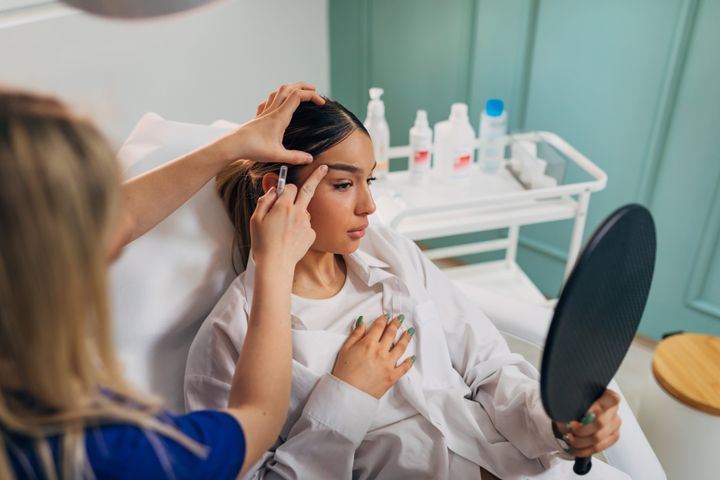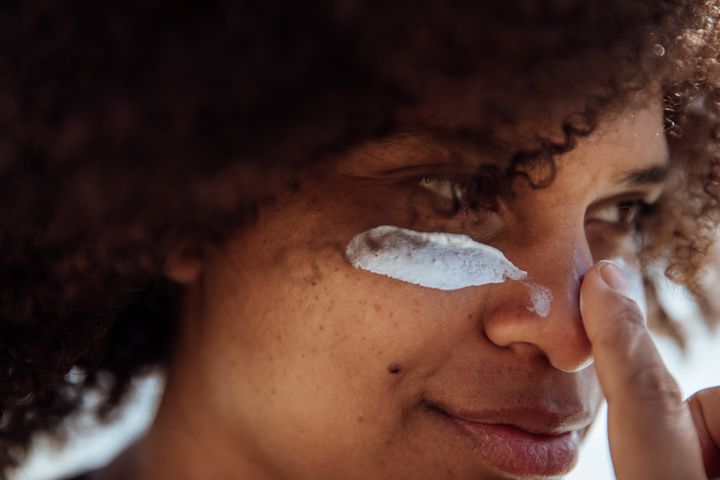News
Why Do Millennials Appear To Be Aging Slower? Here’s The Answer.
Lately, there’s been heightened conversation online about how millennials don’t look their age: How is it that “Bridgerton” star Nicola Coughlan is 37 but genuinely looks 19, the age of her character Penelope Featherington on the show?
How is it that people born in 1993 are now the same age as George Costanza in the first season of “Seinfeld” ― 31 ― while looking about a decade younger? (So sorry to throw you under the bus here, Jason Alexander, we love your work.)
What might be most interesting about the discourse is that a lot of it’s coming from Gen Z, the generation born right after millennials. Conversely, many Gen Z’ers say they feel like they’re aging like spoiled milk.
“We live in a time where millennials look way younger for their age while Gen Z looks way older for their age,” TikTok influencer Jordan Howlett, 27, said in a viral video from January with over 24.8 million views.
“I am Gen Z and nobody ever believes me,” Howlett said. “When my mom and I walk out in public, people think that my mom is my younger sister.” Howlett once asked The Rock for an autograph for himself only to have the actor assume “Jordan” was his son and sign the autograph, “Your dad is a great guy; he stood out here for hours.”
“Dude, Dwayne is 52, I am 26, what?” the influencer joked in the viral video.
Howlett points to work and economic hardships plaguing his generation as the culprit for premature aging.
While that might be, there’s a key element that’s missing from the conversation about the different experiences of aging among millennials (a group aged around 28 to 43 as of 2024) and Gen Z (a group that spans ages 12 to 27): Millennials, on the whole, were the first generation to embrace SPF and avoid smoking, while some in Gen Z are doing the opposite. (More on that later.)
“Millennials have definitely embraced the wisdom and mistakes from the generations before them,” said Dr. Anthony Rossi, a dermatologist, professor and researcher at Memorial Sloan Kettering Cancer Center in New York.
“In general, they took to applying sunscreen diligently and correctly: Putting it on before going out and reapplying as needed,” he said. “That made a difference, especially compared to the generations before them who repeatedly have told me they used baby oil mixed with iodine and sun reflectors to tan and burn.”
“Bad information can lead to real damage.”
– Shamara Bondaroff
Of course, we’re speaking in generalities here: There are members of Gen Z who are hypervigilant about skin care (see: the Sephora baby craze which, rather depressingly, has tweens and teens preoccupied with staving off aging).
And there were certainly millennials who had monthly tanning bed memberships in the early aughts. (Shoutout to all those “Gym, Tan, Laundry” warriors and those who’d wear Playboy stickers to their appointments to get little bunny tan lines. Side note: It’s probably time to get a Tretinoin 0.025% prescription.)
Big mistakes were made in millennials’ skin care game, too: In retrospect, using an apricot scrub nightly like it was a religion was probably a bad idea.
And sure, there’s definitely aging happening in the age group: “People saying millennials look good for their age are not talking about millennial attorneys, just wanted to clear that up,” one man joked on X, the platform formerly known as Twitter.
Still, anecdotally, it seems that millennials by and large heeded the advice given in Baz Luhrmann’s 1999 surprise hit “Everybody’s Free (To Wear Sunscreen)” aka “The Sunscreen Song” and lathered on the SPF.
“Sunscreen is part of their everyday routine, not just reserved for days spent at the beach,” said Dr. Danilo C. Del Campo, a dermatologist at Chicago Skin Clinic and CEO of the skin care line Los Doctores Cubanos.
Cavan Images / Kathleen Carney via Getty Images
Beyond sunscreen, those born in the ’80s and ’90s are pretty meticulous about other parts of their daily skin care routines. As they move deeper into their 30s and 40s, they’re incorporating products with antioxidants and retinoids to slow down some of the tell-tale signs of aging.
Millennials may have lived through the golden age of sugary drinks growing up, but now they cling to their “emotional support water bottles” ― and hydration keeps you looking plump and youthful, too. If they do need to fake tan, they’re not taking their chances with sunbeds and tanning oil; it’s a spray tan this time around.
“Millennials’ skin care regimens are often bolstered by dermatologist recommendations, and it’s a really comprehensive approach,” Del Campo said. “Cleansing, treating, moisturizing, hydrating and then protecting the skin all work to maintain the skin’s health and resilience.”
And, of course, many in the age group are slowing the aging process with “tweakments” like filler and Botox. All of this combined ― sunscreen in their teens and 20s, hyper-specific skin care regimens, maybe even over-hydrating with their beloved Stanley water tumblers, and cosmetic injections ― means that society’s idea of what a 30- or 40-year-old looks like has drastically changed in recent years.
Millennials also weren’t exposed to anti-sunscreen TikTok influencers
According to a 2023 survey from the American Academy of Dermatology, 20% of Gen Z’ers believe that being tan is more important to them than protecting themselves from skin cancer, and 30% admitted that they would rather look “great” today with a tan “even if it means looking worse later in life.”
Those may be alarming stats for sun-wary millennials to digest, but it’s important to realize that millennials had the advantage of growing up at a time where it was largely experts doling out advice, not influencers or self-proclaimed “wellness experts” arguing against the use of sunscreen on TikTok.
In the 1990s, skin cancer began being talked about as major public health problem, as did cancer in general. (Remember everyone wearing those yellow Livestrong bracelets around 2005 or so?)
Millennials heard early and often about the importance of early detection and the role of physician examination and self-examination in spotting troubling skin spots. The dawn of the social media era only amplified your mom’s nonstop “sunscreen helps prevent skin cancer” messaging.
The messaging has become muddled since. While the official guidance from the American Academy of Dermatology is to use broad-spectrum protection SPF of at least 30 that protects against UVA and UVB rays, today’s anti-sunscreen advocates blithely share conspiracy theories that sunscreen causes cancer and was created as a ploy by pharmaceutical companies to boost profits and get people sick.
Most recently, “The Hills” star Kristin Cavallari (a millennial, we should add) caught some heat ― UV ray heat, even! ― for dismissing everyday sunscreen use and platforming a guest who said developing a “base coat” through incremental sun exposure allows the the skin to tolerate the sun without burning.

mjrodafotografia via Getty Images
That definitely wasn’t the messaging millennials were receiving growing up, said Shamara Bondaroff, an esthetician and founder of SB Skin NYC and Miami.
“For a time, the messaging being beamed out about skin protection by actual experts was stronger than it had ever been in the past because of the reach of social media,” she said.
“Some of the most powerful images will always be those of people who wore sun protection on some but not all parts of their bodies, and how that affected their aging process,” she said.
The reality is, studies show that sunscreen protects against all three of the most common skin cancers: squamous cell carcinoma, basal cell carcinoma and melanoma. Since at least one in five Americans will develop skin cancer by the age of 70, according to the Skin Cancer Foundation, it’s definitely worth taking the time to apply sunscreen.
Other culprits for premature aging among Gen Z? Tanning beds, vaping and fillers
It’s not just rampant misinformation about sunscreen that has skin care experts worried about Gen Z’s health. There’s also been a troubling resurgence of tanning bed use among young people, thanks again to TikTok.
“The tanning beds make me cringe,” Rossi said.
“I try to educate Gen Z’ers that any UVA exposure they get does not give them protection,” he said. “There is no such thing as a base tan to help protect you against UVB burns and there is no such thing as a safe tan because any redness or inflammation means that there’s DNA damage.”
Some other culprits that may lead to premature aging? The popularity of vaping. The nicotine and chemicals used in vaping can cause the breakdown of collagen — a protein that helps to keep our skin plump and firm — sometimes resulting in lines around the lips and puffiness around the eyes.
Another reason Gen Z may look a little older than millennials did in their 20s is the normalization of skin fillers among the age group, said Courtney Rubin, a dermatologist and co-founder of Fig.1, a skin care brand.
Sure, millennials get Botox and Juvederm now, too, but they weren’t getting injectables in college. At an impressionable age, Gen Z played around with body dysmorphia-fueling beauty filters on Snapchat and watched their favorite influencers go to in-office filler procedures.

“I’m seeing many clients start getting filler in their 20s, which didn’t used to be the case,” Rubin told HuffPost. “Filler works great as a way to replace volume that has been lost over time, as a restorative treatment, but when you are in your 20s, you haven’t lost any volume yet.”
What happens is that people who are getting filler in their 20s are using it not really as a tool for restoration, but rather as a tool for facial change, Rubin said. Chin fillers to create a stronger jawline, for instance.
“When we are making major changes to facial features, there is an increased risk of something not looking quite right,” the dermatologist said.
Others are going to further extremes, getting buccal fat removal, a surgery where facial fat is removed to achieve a sweeping, Marlene Dietrich-esque jawline. (The problem, as some plastic surgeons have noted, is that removing a large portion of the buccal fat pad can prematurely age you; facial fat tends to plump up the skin and make you look young; removing it can have the opposite effect.)
Overall, it’s hard to tell how Gen Z’s approach to skin care will unfold: There’s plenty of sun-conscious, hydrated Gen Z’ers who are waiting or conservative on fillers.
“Unfortunately, there is still a lot of terrible advice out there from people who have no business dispensing advice, but that’s the world we live in,” Bondaroff said.
It’s easy to get influenced while mindlessly scrolling, but skin care is health care, Bondaroff said; it’s absolutely not in the same category as makeup or hair: “Bad information can lead to real damage,” she said.
The esthetician has faith, though.5
“I think a lot of Gen Z, through social media, know that they can talk to anyone from their esthetician to their dermatologist to their primary care doctor about their skin and get a better idea of how to approach any problems they may be experiencing,” she said.

